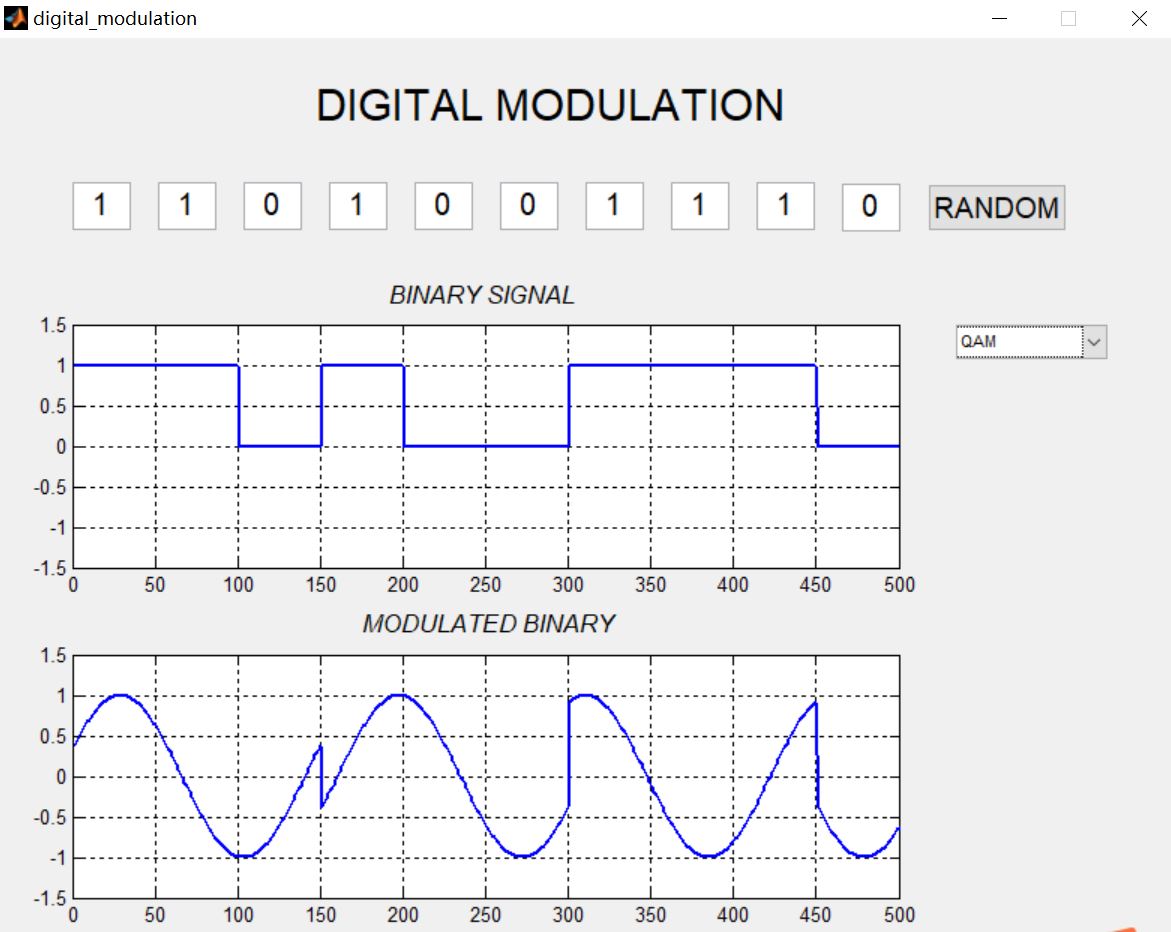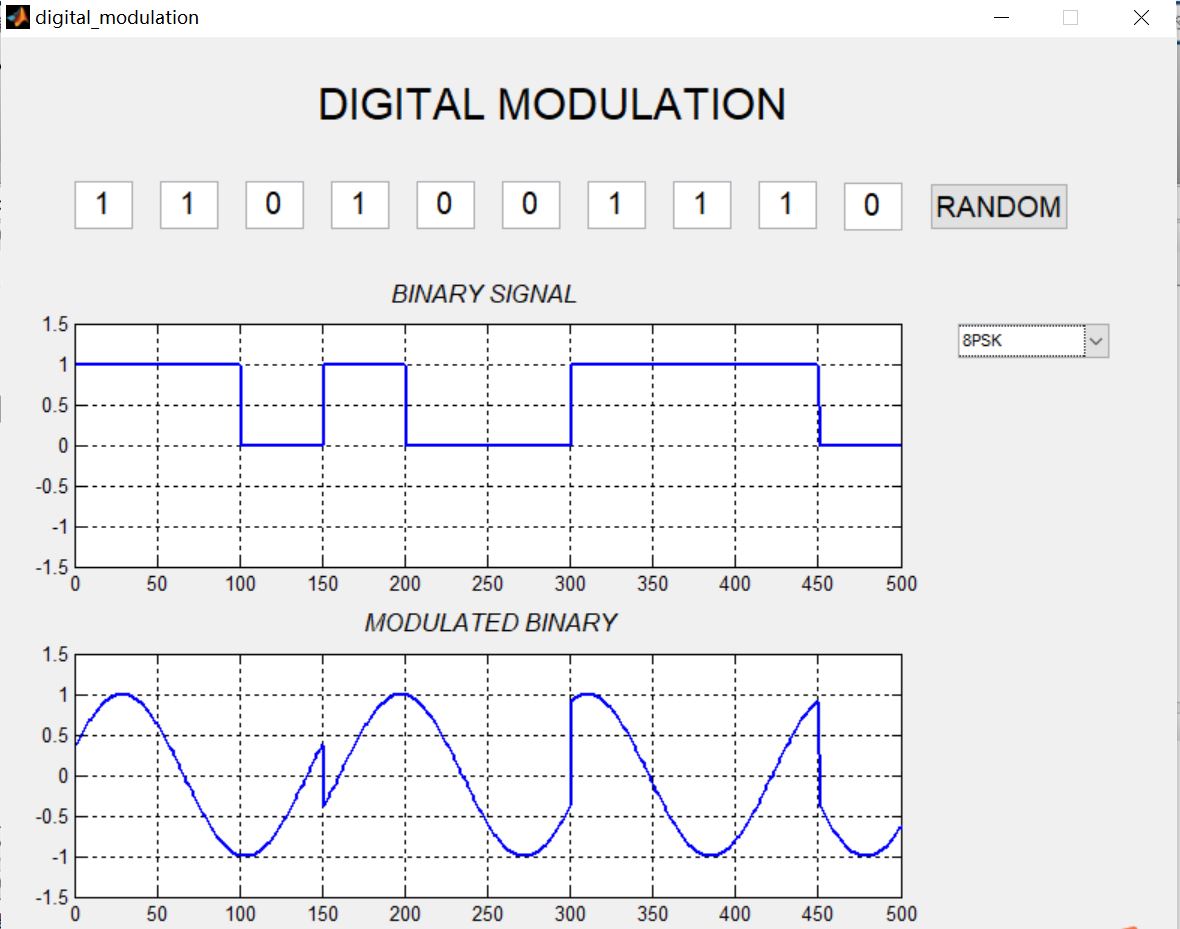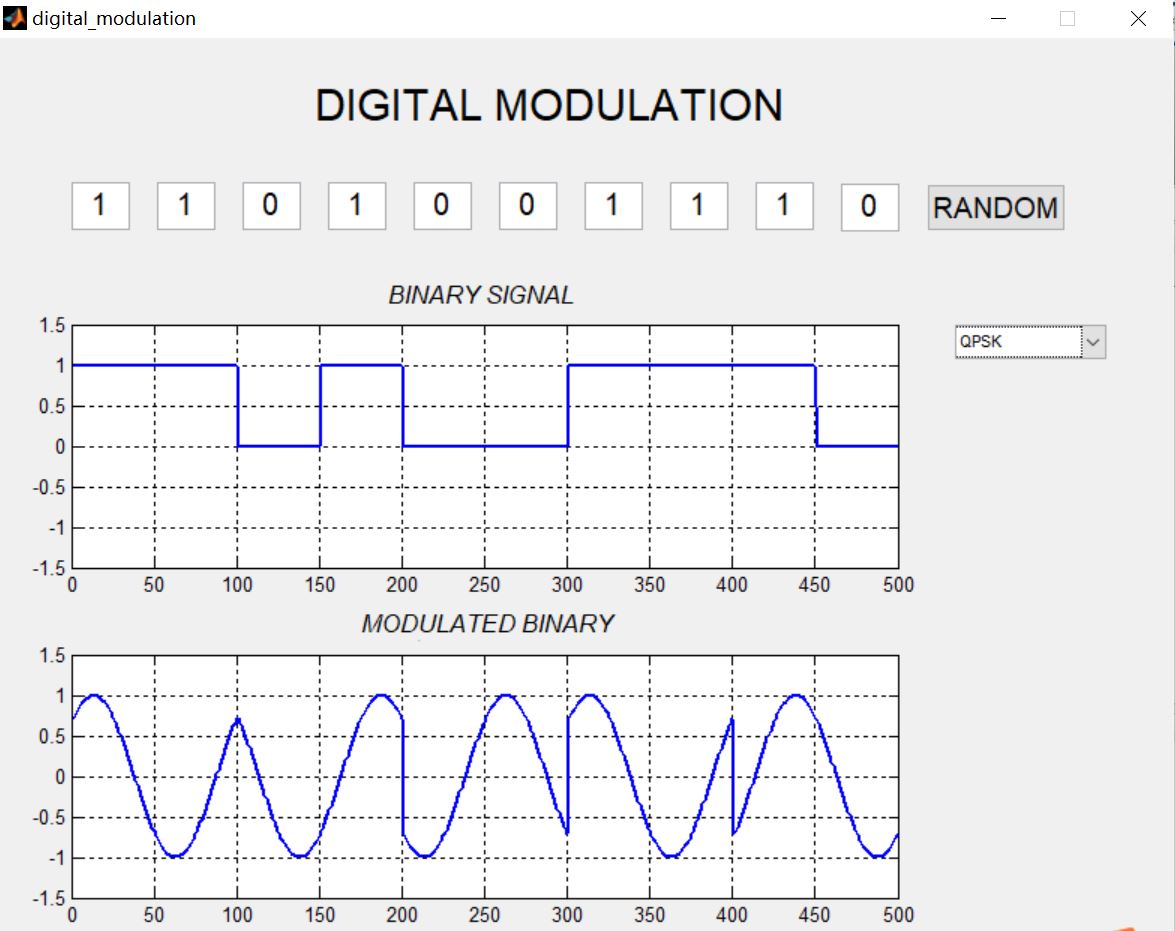数字信号调制基于matlab GUI ASK+OOK++BPSK+8PSK+QPSK+AM调制解调含Matlab源码 1368期
Posted 紫极神光
tags:
篇首语:本文由小常识网(cha138.com)小编为大家整理,主要介绍了数字信号调制基于matlab GUI ASK+OOK++BPSK+8PSK+QPSK+AM调制解调含Matlab源码 1368期相关的知识,希望对你有一定的参考价值。
一、简介
1 绪论
调制:把消息信号寄托到载波的某个参数上,形成已调信号。
解调:调制的逆过程,从已调信号中恢复消息信号。
2 调制的目的
无线通信中,匹配信道特性,提高发射信号的频率,减小天线尺寸;频谱搬移,一条信道中同时传输多路信号,多路复用,提高信道利用率;扩展信号带宽,提高系统抗干扰能力;实现带宽与信噪比的互换(有效性和可靠性);利用电话线将PC机接入Internet,需要翻译模/数信号。
3 调制的分类
3.1 涉及的信号
消息信号,又称调制信号、基带信号;
载波:运载工具,常用的是正弦波、脉冲序列;
已调信号:受调载波,载有消息信号的信息,具有多种形式。
3.2 可以从不同角度分类
按调制信号的类型:模拟调制/数字调制
按已调信号的频谱结构:线性调制/非线性调制
按正弦载波的受调参量:幅度调制/频率调制/相位调制
按载波信号的类型:连续波调制/脉冲调制
4 幅度调制
4.1 一般模型
(1)理论基础:傅里叶变换
(2)一般模型
幅度调制:消息信号控制正弦载波的幅度。
方法:用消息信号通过相乘器乘上载波信号,再通过带通滤波器(时域卷积滤波器特性)。
举例:AM、DSB、SSB、VSB。
4.2 常规双边带调幅AM
t 域:已调信号的波形,调制/解调方法
f 域:已调信号的频谱,带宽B
AM信号的包络正比于消息信号的规律,因此可以采用简单的**包络检波方法(非相干解调)**解调;
频谱由载波、上边带USB、下边带LSB组成。带宽BAM=2fH;
幅度调制又称为线性调制;
应用:中短波调幅广播。
缺点:功率利用率低,最多达到50%
4.3 抑制载波双边带DSB
频谱由上边带USB、下边带LSB组成,没有了载波分量。带宽BDSB=BAM=2fH;
调制效率可达100%。
采用相干解调:
方法:用消息信号通过想乘器乘上相干载波信号,再通过低通滤波器(时域卷积滤波器特性)。
要求:载波同步(相干载波和载波信号同频同相)
4.4 单边带调制SSB
只传输一个边带,频带利用率高。带宽BSSB=BAM/2=fH;在频谱拥挤的通信场合,如短波通信、多路载波电话系统。低功耗特性。使用于移动通信系统。
缺点:设备复杂,存在技术难点,需要相干解调。
4.5 残留边带调制VSB
残留边带滤波器特性:在载频处具有互补对称特性;介于单边带与双边带之间的方案。
5 角度调制
正弦载波有三个参量:幅度、频率、相位。都可以携带消息信号。
其中,频率(FM)和相位(PM)都称为角度调制。
频率调制(FM)
幅度恒定,对瞬时相位对t求微分,得到瞬时角频率。
调频的频谱由载频分量wc两侧的无数多对边频wc±nwm组成,其幅度取决于mf;
理论上,调频的带宽无穷大;
实际中,用卡森公式计算FM带宽:BFM=2(mf+1)fm。fm为调制信号的最高频率
FM调制为非线性调制。FM解调也称鉴频 ,采用微分电路+包络检波实现。
FM的特点和应用
特点:幅度不变,包络恒定。
优势:抗噪能力强;
代价:占用较大信道带宽,频谱利用率低;
应用:高质量或信道噪声大的场合。如卫星通信、移动通信、微波通信等。
6 抗噪声性能
性能指标:输出信噪比、制度增益
输入信噪比:Ni=n0B。n0是噪声的单边功率谱密度,B=2fH是带宽,是基带带宽的2倍。
AM DSB SSB VSB(幅度调制)
相干解调器:线性解调,信号和噪声可以分开处理。
双边带和单边带调制的抗噪声性能相同。
小信噪比时,信号被干扰为噪声,产生门限效应。原因是包络检波的非线性解调作用。
信噪比固定。
FM(角度调制)
FM系统可以通过增加传输带宽来改善抗噪声性能(信噪比)。
总结
频谱利用率 SSB>VSB>DSB/AM>FM
抗噪声性能:FM>DSB/SSB>VSB>AM
设备复杂度:AM最简,DSB/FM次之,SSB最复杂
二、部分源代码
function varargout = digital_modulation(varargin)
%DIGITAL_MODULATION
% Begin initialization code - DO NOT EDIT
gui_Singleton = 1;
gui_State = struct('gui_Name', mfilename, ...
'gui_Singleton', gui_Singleton, ...
'gui_OpeningFcn', @digital_modulation_OpeningFcn, ...
'gui_OutputFcn', @digital_modulation_OutputFcn, ...
'gui_LayoutFcn', [] , ...
'gui_Callback', []);
if nargin && ischar(varargin{1})
gui_State.gui_Callback = str2func(varargin{1});
end
if nargout
[varargout{1:nargout}] = gui_mainfcn(gui_State, varargin{:});
else
gui_mainfcn(gui_State, varargin{:});
end
% End initialization code - DO NOT EDIT
% --- Executes just before digital_modulation is made visible.
function digital_modulation_OpeningFcn(hObject, eventdata, handles, varargin)
% This function has no output args, see OutputFcn.
% hObject handle to figure
% eventdata reserved - to be defined in a future version of MATLAB
% handles structure with handles and user data (see GUIDATA)
% varargin command line arguments to digital_modulation (see VARARGIN)
hold off;
axes(handles.axes1);
h=[1 1 0 1 0 0 1 1 1 0];
hold off;
bit=[];
for n=1:2:length(h)-1;
if h(n)==0 & h(n+1)==1
se=[zeros(1,50) ones(1,50)];
elseif h(n)==0 & h(n+1)==0
se=[zeros(1,50) zeros(1,50)];
elseif h(n)==1 & h(n+1)==0
se=[ones(1,50) zeros(1,50)];
elseif h(n)==1 & h(n+1)==1
se=[ones(1,50) ones(1,50)];
end
bit=[bit se];
end
plot(bit,'LineWidth',1.5);grid on;
axis([0 500 -1.5 1.5]);
%*-*-*-*-*-*-*-*-*-*-*-*-*-*-*-*-*-*-*-*-*-*-
axes(handles.axes3)
hold off;
fc=30;
g=[1 1 0 1 0 0 1 1 1 0]; %modulante
n=1;
while n<=length(g)
if g(n)==0
tx=(n-1)*0.1:0.1/100:n*0.1;
p=(1)*sin(2*pi*fc*tx);
plot(tx,p,'LineWidth',1.5);grid on;
hold on;
else
tx=(n-1)*0.1:0.1/100:n*0.1;
p=(2)*sin(2*pi*fc*tx);
plot(tx,p,'LineWidth',1.5);grid on;
hold on;
end
n=n+1;
end
% Choose default command line output for digital_modulation
handles.output = hObject;
% Update handles structure
guidata(hObject, handles);
% UIWAIT makes digital_modulation wait for user response (see UIRESUME)
% uiwait(handles.figure1);
% --- Outputs from this function are returned to the command line.
function varargout = digital_modulation_OutputFcn(hObject, eventdata, handles)
% varargout cell array for returning output args (see VARARGOUT);
% hObject handle to figure
% eventdata reserved - to be defined in a future version of MATLAB
% handles structure with handles and user data (see GUIDATA)
% Get default command line output from handles structure
varargout{1} = handles.output;
% --- Executes on button press in random.
function random_Callback(hObject, eventdata, handles)
% hObject handle to random (see GCBO)
% eventdata reserved - to be defined in a future version of MATLAB
% handles structure with handles and user data (see GUIDATA)
a=round(rand(1,10)); %genarar bits aleatorios
ran=[a(1),a(2),a(3),a(4),a(5),a(6),a(7),a(8),a(9),a(10)];
set(handles.bit1,'String',ran(1));
set(handles.bit2,'String',ran(2));
set(handles.bit3,'String',ran(3));
set(handles.bit4,'String',ran(4));
set(handles.bit5,'String',ran(5));
set(handles.bit6,'String',ran(6));
set(handles.bit7,'String',ran(7));
set(handles.bit8,'String',ran(8));
set(handles.bit9,'String',ran(9));
set(handles.bit10,'String',ran(10));
%*-*-*-*-*-*-*-*-*-*-*-*-*-*-*-*-*-*-*-*-*-*
handles.bits=ran;
h=handles.bits;
axes(handles.axes1)
hold off;
bit=[];
for n=1:2:length(h)-1;
if h(n)==0 & h(n+1)==1
se=[zeros(1,50) ones(1,50)];
elseif h(n)==0 & h(n+1)==0
se=[zeros(1,50) zeros(1,50)];
elseif h(n)==1 & h(n+1)==0
se=[ones(1,50) zeros(1,50)];
elseif h(n)==1 & h(n+1)==1
se=[ones(1,50) ones(1,50)];
end
bit=[bit se];
end
plot(bit,'LineWidth',1.5);grid on;
axis([0 500 -1.5 1.5]);
%*-*-*-*-*-*-*-*-*-*-*-*-
hold off;
axes(handles.axes3);
cod=get(handles.select_mod,'Value');
switch cod
%*-*-*-*Modulation ASK*-*-*-*-*-*-*-*-*
case 1
hold off;
axes(handles.axes3)
fc=30;
g=handles.bits; %modulante
n=1;
while n<=length(g)
if g(n)==0
tx=(n-1)*0.1:0.1/100:n*0.1;
p=(1)*sin(2*pi*fc*tx);
plot(tx,p,'LineWidth',1.5);grid on;
hold on;
% axis([0 n*2/fc -3 3]);
else
tx=(n-1)*0.1:0.1/100:n*0.1;
p=(2)*sin(2*pi*fc*tx);
plot(tx,p,'LineWidth',1.5);grid on;
hold on;
end
n=n+1;
end
%*-*-*-*-*-*-*-Modulation OOK*-*-*-*-*-*-*-*-*-
case 2
hold off;
axes(handles.axes3);
t=0:0.001:1;
m=1;
fc=30;
g=handles.bits; %modulante
n=1;
while n<=length(g)
tx=(n-1)*1/length(g):0.001:n*1/length(g);
p=(g(n))*sin(2*pi*fc*tx);
plot(tx,p,'LineWidth',1.5);
hold on;
axis([0 (n)*1/length(g) -1.5 1.5]);
grid on;
n=n+1;
end
%*-*-*-*-*-*-*-Modulation BPSK*-*-*-*-*-*-*-*-*-*-*-
case 3
axes(handles.axes3)
hold off;
g=handles.bits;
fc=10;
n=1;
while n<=length(g)
if g(n)==0 %0 is -1
tx=(n-1)*0.1:0.1/100:n*0.1;
p=(-1)*sin(2*pi*fc*tx);
plot(tx,p,'LineWidth',1.5);grid on;
hold on;
else
tx=(n-1)*0.1:0.1/100:n*0.1;
p=(1)*sin(2*pi*fc*tx);
plot(tx,p,'LineWidth',1.5);grid on;
hold on;
end
n=n+1;
end
三、运行结果



